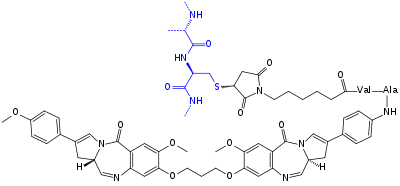Vadastuximab talirine
| Monoclonal antibody | |
|---|---|
| Type | Whole antibody |
| Source | Chimeric (mouse/human) |
| Target | CD33 |
| Clinical data | |
| Synonyms | SGN-CD33A |
| ATC code |
|
| Identifiers | |
| CAS Number | |
| ChemSpider |
|
| UNII | |
Vadastuximab talirine or SGN-CD33A is an antibody-drug conjugate or ADC directed to CD33 (SIGLEC-3), which is a transmembrane receptor expressed on cells of myeloid lineage. The trial drug, being developed by Seattle Genetics and currently in clinical trials, is designed for the treatment of acute myeloid leukemia (AML).[1][2] Acute myeloid leukemia remains a major challenge in the treatment of hematologic oncology. According to the American Cancer Society, an estimated 13,780 new cases and 10,200 deaths occurred in the United States in 2012.[3]
Target, antibody, linker and cytotoxin
The drug target, CD33, is expressed on most AML cells. The CD33 antibody is attached to a potent DNA binding agent, a pyrrolobenzodiazepine (PBD) dimer (SGD-1882), via a cleavable (valine-alanine dipeptide as cathepsin B cleavage site) maleimidocaproyl type linker, to a monoclonal antibody with engineered cysteines (EC-mAb). Vadastuximab talirine contains two such cysteines. This use of engineered cysteine residues at the sites of drug linker attachment results in a drug loading of approximately two PBD dimers per antibody. PBD dimers are significantly more potent than systemic chemotherapeutic drugs and the site-specific conjugation technology (EC-mAb) allows uniform drug-loading of the cell-killing PBD agent to the anti-CD33 antibody.[4]
Clinical trials
The drug has concluded phase I clinical trials for acute myeloid leukemia.[5] Interim results were presented in Dec 2014.[6] and published April 2015.[7]
Based on interim data from ongoing phase I clinical trials presented at the 57th Annual Meeting of the American Society of Hematology (ASH), researchers at Seattle Genetics have planned a phase III clinical trial to begin in 2016. This phase III study is expected to evaluate vadastuximab talirine in combination with hypomethylating agents (HMAs; azacitidine, decitabine) in previously untreated older AML patients. The drug is also being evaluated broadly across multiple lines of therapy in patients with myeloid malignancies, including in ongoing and planned phase I and II clinical trials for newly diagnosed or relapsed AML and for newly diagnosed myelodysplastic syndrome or MDS.[4]
The phase 3 HMA combination trial (called CASCADE) was halted early (June 2017) due to safety concerns.[8]
Orphan drug designation
Vadastuximab talirine was granted orphan drug designation by both the U.S. Food and Drug Administration (FDA) and the European Commission for the treatment of AML.[4]
See also
- Rovalpituzumab tesirine, with a similar cytotoxin
References
- ↑ SGN-CD33A: A Novel CD33-Directed Antibody-Drug Conjugate, Utilizing Pyrrolobenzodiazepine Dimers, Demonstrates Preclinical Antitumor Activity Against Multi-Drug Resistant Human AML; 54th ASH 2012; Julie A. McEarchern, PhD
- ↑ Pyrrolobenzodiazepine (PBD); ADC Review / Journal of Antibody-drug Conjugates (March 16, 2015)
- ↑ Siegel R, Naishadham D, Jemal A. Cancer statistics, 2012. CA Cancer J Clin. 2012 Jan-Feb;62(1):10-29. doi: 10.3322/caac.20138. Epub 2012 Jan 4.
- 1 2 3 4 Vadastuximab talirine (SGN-CD33a) drug description; ADC Review / Journal of Antibody-drug Conjugates (November 23, 2015)
- ↑ NCT01902329:A Safety Study of SGN-CD33A in AML Patients
- ↑ Interim Analysis of a Phase I Trial of SGN-CD33A in Patients with CD33-Positive Acute Myeloid Leukemia (AML)
- ↑ Abstract DDT02-04: SGN-CD33A: Preclinical and phase I interim clinical trial results of a CD33-directed PBD dimer antibody-drug conjugate for the treatment of acute myeloid leukemia (AML)
- ↑ Seattle Genetics halts trials of latest ADC after safety warning. June 2017
